Lithosphere - coasts
1/83
Earn XP
Description and Tags
Name | Mastery | Learn | Test | Matching | Spaced |
|---|
No study sessions yet.
84 Terms
Coasts
These are areas where the sea meets the land
What are the two types of coastlines?
Coastlines of deposition and coastlines of erosion
How are coastlines shaped?
Waves are the main power force that changes coastlines
Formation of a wave
When wind blows across the surface of the water
What are the three things that influence the power and size of a wave?
Distance travelled by the wave
Duration of the wind
Strength of the wind
Fetch
The distance travelled by a wave
Long fetch
Waves that travel a long distance produce powerful waves
Short fetch
Waves that travel a short distance produce smaller waves
How do waves shape a coastline?
When waves hit the coastline, they move water and material onto the coast, and also drag it backwards towards the sea
Swash
Movement of waves up the beach
Backwash
Movement of waves back down the beach
Wavelength
The distance between the crests (tops) of the waves
What are the two types of waves?
Constructive waves and destructive waves
What two things determine the type of wave?
The energy of the swash and backwash
Destructive waves
Powerful waves that are high in energy, often crashing down onto the beach and coastline that removes materials
Constructive waves
Gentle waves that are low in energy, often rolling up onto the beach and coastline that adds materials
Characteristics of destructive waves
Strong backwash
Tall waves, which break downwards with force
Waves are steep and close together
Weak swash
Characteristics of constructive waves
Gentle waves roll onto the beach
Strong swash
Waves are low and far apart
Weak backwash
Swash and backwash of destructive waves
The backwash is stronger than the swash
Swash and backwash of constructive waves
The swash is stronger than the backwash
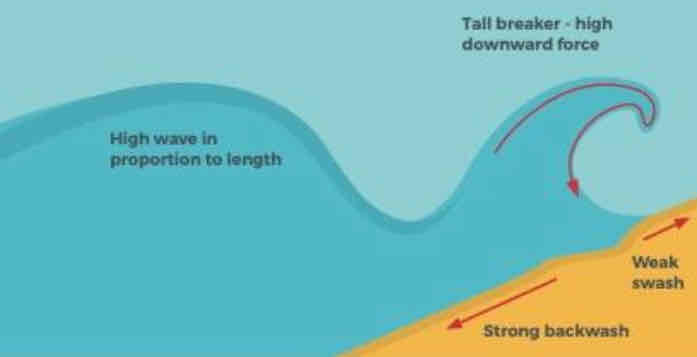
Destructive waves

Constructive waves
What are the four processes of coastal erosion?
Abrasion
Attrition
Hydraulic action
Solution
Abrasion
Waves repeatedly throw loose rocks against the base of the cliff, causing more fragments to break off
Attrition
Loose rocks carried by the waves crash into each other, making them smaller and rounder
Hydraulic action
Waves crash against cliffs, forcing air and water into cracks, which creates pressure in the cracks causing them to explode open
Solution
Salts and acids in the seawater dissolve minerals in the rocks, leaving small hollows in the rocks
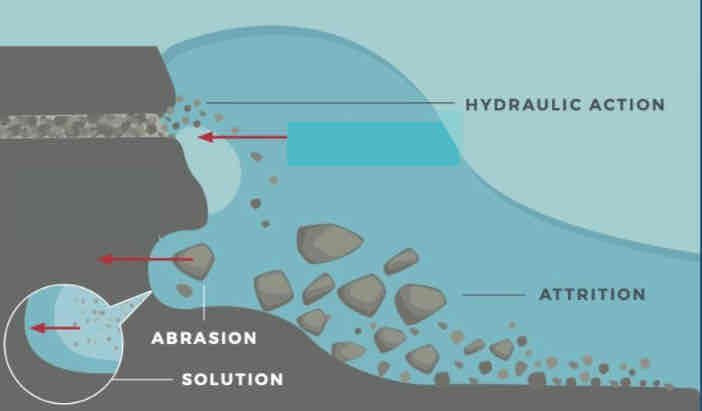
Processes of coastal erosion

Concordant coastline

Discordant coastline
What are the two factors that affect erosion?
Geology and wave fetch
Geology
Hard igneous and metamorphic rock is more difficult to erode than soft sedimentary rock
Wave fetch
The greater the fetch of a wave, the more power it has to erode
What are the two types of geology structures that affect the way a coastline erodes?
Concordant coastlines and discordant coastlines
Concordant coastlines
These occur when the geology of an area runs parallel to the coastline, only one type of rock is exposed to the processes of coastal erosion, which will erode at the same rate
Discordant coastlines
These occur when the geology of an area runs perpendicular to the coastline, multiple types of different rocks are exposed to the processes of coastal erosion, which will erode at different rates
Differential erosion
When some rocks erode more easily than others the rate of erosion will differ depending on the geology of the area
How are headlands and bays formed?
Differential erosion
Headland
An area of hard (resistant) rock that extends out into the sea
Bay
An inlet of the sea, surrounded by land
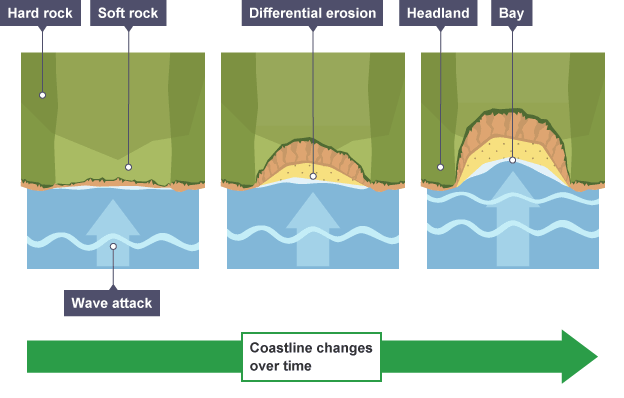
Formation of a headland and bay
Bands of soft rock are weaker, therefore they erode more quickly, which forms bays
Bands of hard rock are more resistant to erosion as they are stronger, which forms headlands
Headlands protect the bays from destructive waves
Beaches start to form in bays as waves deposit sediment
What geological structure is required for headlands and bays to form?
Discordant coastlines
Named example: headland and bay
Durdle Door, Dorset
Wave-cut platform
These are flat areas of rock which form at the base of a cliff
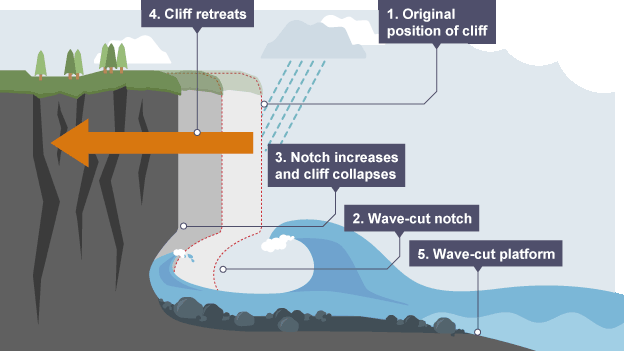
Formation of a wave-cut platform
Overtime cliffs retreat backwards due to wave erosion
Waves attack the base of the cliff, becoming unsupported
The cliff will eventually collapse into the sea
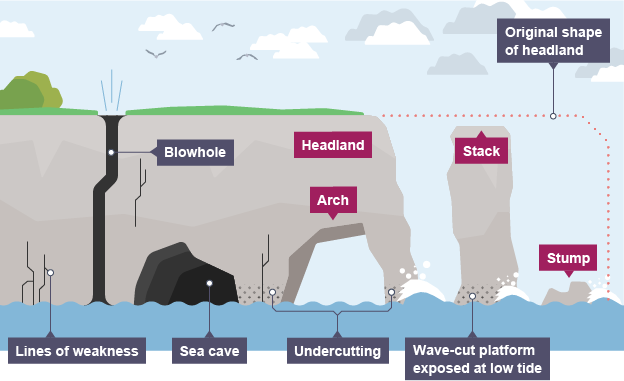
Lines of weakness, blowhole, sea cave, arch, stack, and a stump
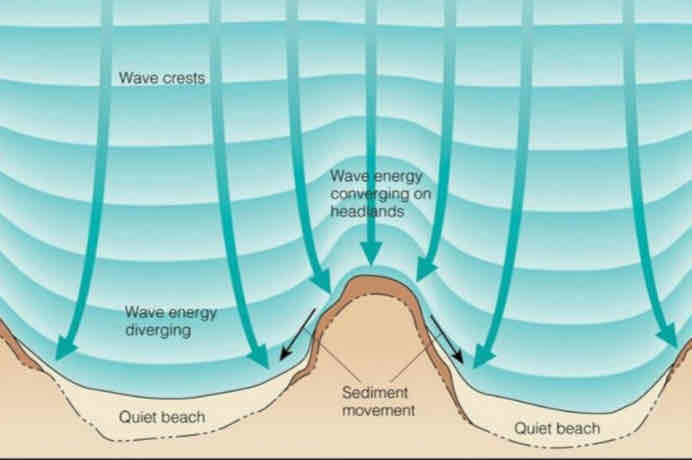
Erosion of headlands
Erosion of headlands
As headlands and bays form, headlands become more and more exposed to destructive waves, making them vulnerable to erosion
Named example: sea cave, arch, stack, and stump
Old Harry and his Wife
What are the five stages of coastal erosion (explain the stages in order)
Lines of weakness
Sea cave
Arch
Stack
Stump
Stage one of coastal erosion: lines of weakness
Waves attack weaknesses in the headland through the processes of abrasion and hydraulic action, forming cracks in the base
Stage two of coastal erosion: formation of a sea cave
Cracks are eroded further through abrasion and hydraulic action, forming a sea cave
Stage three of coastal erosion: formation of an arch
The waves erode the sides and back of the sea cave until they break through to the other side of the headland, forming an arch
Stage four of coastal erosion: formation of a stack
Waves continue to erode the arch, widening it and weakening the top, the roof then becomes unsupported and collapses, leaving a free-standing piece of rock called a stack
Stage five of coastal erosion: formation of a stump
The stack is continually eroded at the base, becoming weaker until it eventually collapses and leaves a stump
Blowhole
This may form if the erosion at the back of a sea cave breaks through the top of the cliff as compressed air is pushed upwards by the power of the waves
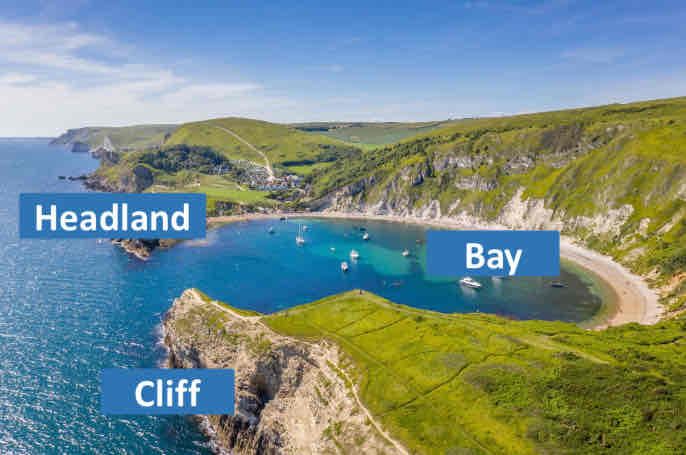
Bay, cliff, and headland
Named example: wave-cut platform
Durlston cliffs
What are the three stages of coastal deposition (explain the stages in order)
Sand spit
Sand bar
Tombolo
Named example: sand spit
Spurn Head, Yorkshire
Named example: sand bar
Chesil beach, Dorset
Named example: tombolo
St Ninian’s isle, Shetland
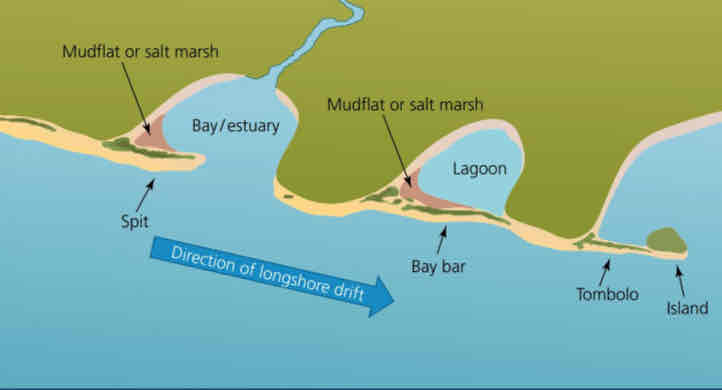
Sand spit, sand bar, and tombolo
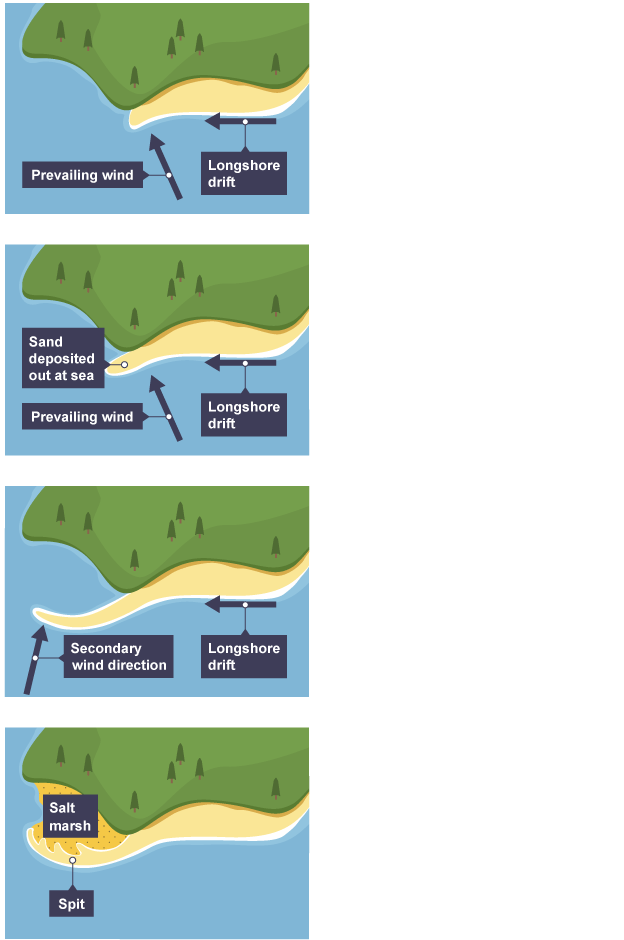
Stage one of coastal deposition: formation of a sand spit
Longshore drift moves the materials along the beach sideways
Waves lose energy and start to deposit materials in calm and sheltered water, overtime the deposited material will begin to build up until it is above the sea level
Deposition continues to occur until the beach extends into the sea, forming a spit
Sand spits can develop a hooked or curved end, caused by a change in wind and wave direction
Mud flats or salt marshes can develop in areas of calm water behind a spit
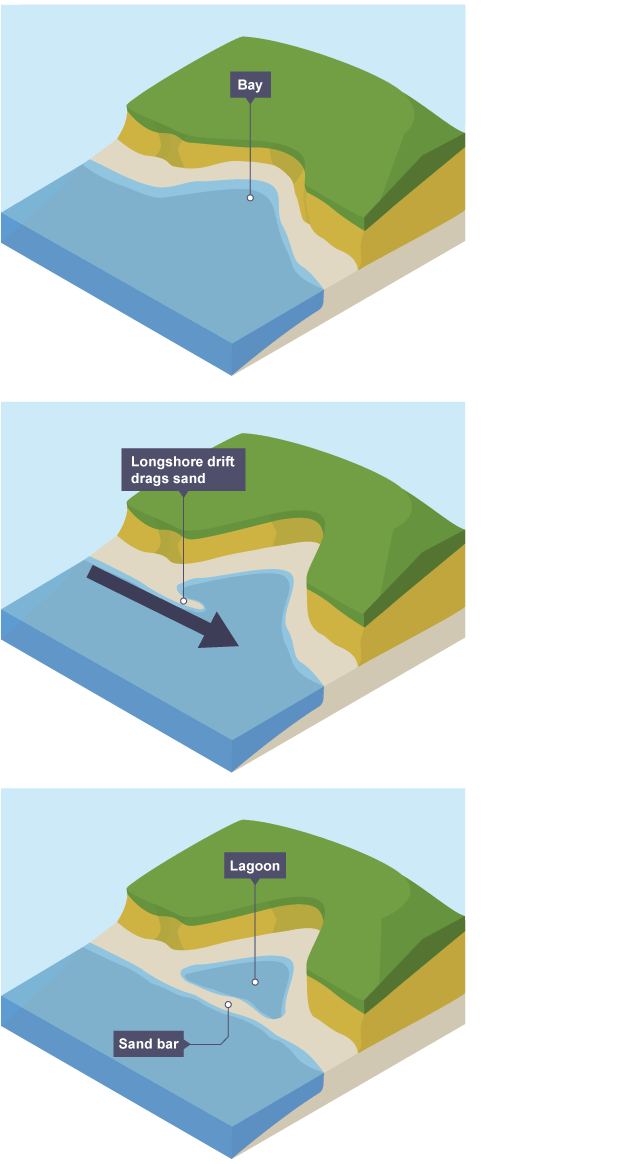
Stage two of coastal deposition: formation of a sand bar
If a spit continues to grow out until it joins with the opposite side of a bay, a sand bar is formed
This happens when there is no strong flow of water from a river into the sea, enclosing a sheltered lagoon behind it
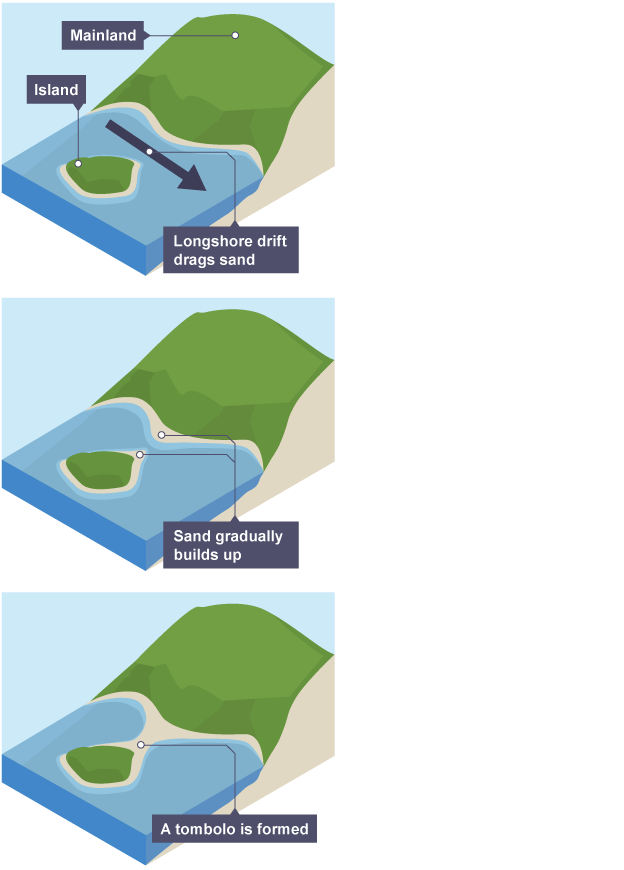
Stage three of coastal deposition: formation of a tombolo
When longshore drift deposits sediment and extends a spit out from the headland, connecting to an island
This leaves a long, thin strip of beach

Wave-cut platform
Coastal deposition
This is when waves lose energy and deposit materials
Erosion
The wearing away and removal of materials such as rocks and soils
What are the four formations created through coastal erosion?
Sea cave
Arch
Stack
Stump
What three processes are waves capable of doing?
Deposition
Erosion
Transportation
Coastal transportation
This is when waves transport materials
Longshore drift
This is a process where pebbles and other materials are moved sideways along a beach by the waves that are driven from the prevailing wind
What is the dominant processes of coastal transportation?
Longshore drift
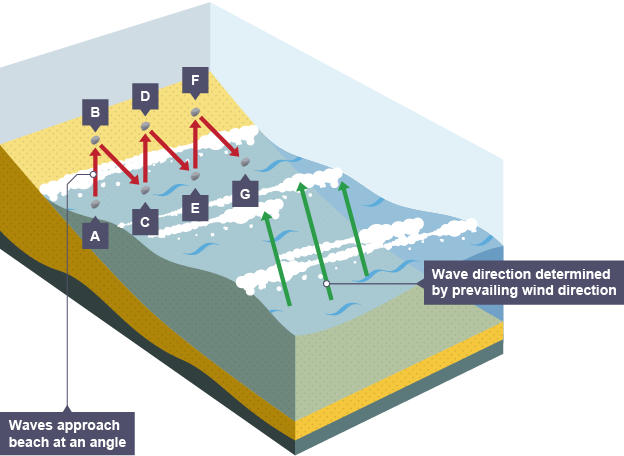
Longshore drift
Process of longshore drift
Waves approach the coast at an angle, due to the prevailing wind, carrying material with them
When waves break, the swash carries water and material up the beach at the same angle
Waves drag materials back out to sea in the backwash, the backwash travels at right angles to the beach due to gravity
This results in the zig-zag movement of material along the coast
Prevailing wind
Winds that blow from a single directio nover an area of the Earth’s atmosphere
Sand spit
A long, narrow ridge of sand that extends out into the sea from one end of the mainland, caused by waves depositing materials
What two things are required for a sand spit to form?
The coastline must change direction and the water must be shallow and gentle
Sand bar
Stretches of sand formed across a bay through longshore drift
Tombolo
Stretches of deposited material that reaches out from the coastline to a small island
What are the three processes involved in the formation of a wave-cut platform?
Abrasion
Attrition
Hydraulic action
What are the three processes involved in the formation of a headland and bay?
Abrasion
Attrition
Hydraulic action
What are the three processes involved in the formation of a cave, arch, stack, and a stump?
Abrasion
Attrition
Hydraulic action